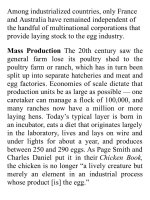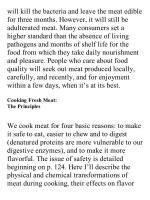On food and cooking the science and lore of the kitchen ( PDFDrive ) 261
Bạn đang xem bản rút gọn của tài liệu. Xem và tải ngay bản đầy đủ của tài liệu tại đây (118.88 KB, 2 trang )
unloaded oxygen into our cells.) And when
oxygen manages to rob the iron atom of an
electron and then escape, the iron atom loses
its ability to hold oxygen at all, has to settle
for a water molecule, and the myoglobin
becomesbrown.
Whiteandredmusclefibers.Fastmusclecells
are thicker than slow cells, contain little
oxygen-storing myoglobin pigment and few
fat-burning mitochondria. The thinness of
slow,redmusclefibersspeedsthediffusionof
oxygen from the external blood supply to the
centerofthefibers.
Eachofthesemyoglobins—thered,the
purple,andthebrown—ispresentinred
meat.Theirrelativeproportions,andsothe
meat’sappearance,aredeterminedbyseveral
factors:theamountofoxygenavailable,the
activityofoxygen-consumingenzymesinthe
muscletissue,andtheactivityofenzymes
thatcanresupplybrownmyoglobinwithan
electron,whichturnsitpurpleagain.Acidity,
temperature,andsaltconcentrationalso
matter;ifanyishighenoughtodestabilizethe
attachedprotein,myoglobinismorelikelyto
loseanelectronandturnbrown.Generally,
freshredmeatwithactiveenzymesystems
willberedonthesurface,whereoxygenis
abundant,andpurpleinside,wherethelittle
oxygenthatdiffusesthroughisconsumedby
enzymes.Whenwecutintorawmeatorintoa
raresteak,theinitiallypurpleinteriorquickly
“blooms,”orreddens,thankstoitsdirect
exposuretotheair.Similarly,vacuum-packed
meatappearspurpleduetotheabsenceof
oxygen,andreddensonlywhenremovedfrom
thepackage.
Thepinkcolorofsalt-curedmeatscomes
fromyetanotheralterationofthemyoglobin
molecule(p.148).









